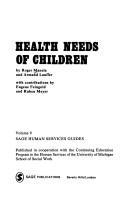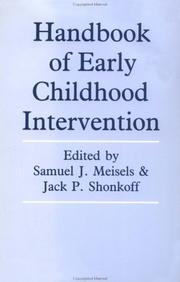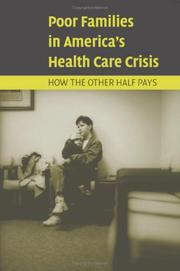| Listing 1 - 10 of 26 | << page >> |
Sort by
|
Book
Year: 2008 Publisher: Washington, D.C., The World Bank,
Abstract | Keywords | Export | Availability | Bookmark
 Loading...
Loading...Choose an application
- Reference Manager
- EndNote
- RefWorks (Direct export to RefWorks)
This paper uses a sample of 73 developing countries to estimate the change in the cost of alleviating urban poverty brought about by the recent increase in food prices. This cost is approximated by the change in the poverty deficit, that is, the variation in financial resources required to eliminate poverty under perfect targeting. The results show that, for most countries, the cost represents less than 0.1 percent of gross domestic product. However, in the most severely affected, it may exceed 3 percent. In all countries, the change in the poverty deficit is mostly due to the negative real income effect of those households that were poor before the price shock, while the cost attributable to new households falling into poverty is negligible. Thus, in countries where transfer mechanisms with effective targeting already exist, the most cost-effective strategy would be to scale up such programs rather than designing tools to identify the new poor.
Debt Markets --- Finance and Financial Sector Development --- Food and Beverage Industry --- Food prices --- Income --- Industry --- New poor --- Poor --- Poor households --- Poverty --- Poverty gap --- Poverty line --- Poverty Reduction --- Poverty threshold --- Pro-Poor Growth --- Rural Development --- Rural Poverty Reduction --- Targeting
Book
Year: 2008 Publisher: Washington, D.C., The World Bank,
Abstract | Keywords | Export | Availability | Bookmark
 Loading...
Loading...Choose an application
- Reference Manager
- EndNote
- RefWorks (Direct export to RefWorks)
This paper uses a sample of 73 developing countries to estimate the change in the cost of alleviating urban poverty brought about by the recent increase in food prices. This cost is approximated by the change in the poverty deficit, that is, the variation in financial resources required to eliminate poverty under perfect targeting. The results show that, for most countries, the cost represents less than 0.1 percent of gross domestic product. However, in the most severely affected, it may exceed 3 percent. In all countries, the change in the poverty deficit is mostly due to the negative real income effect of those households that were poor before the price shock, while the cost attributable to new households falling into poverty is negligible. Thus, in countries where transfer mechanisms with effective targeting already exist, the most cost-effective strategy would be to scale up such programs rather than designing tools to identify the new poor.
Debt Markets --- Finance and Financial Sector Development --- Food and Beverage Industry --- Food prices --- Income --- Industry --- New poor --- Poor --- Poor households --- Poverty --- Poverty gap --- Poverty line --- Poverty Reduction --- Poverty threshold --- Pro-Poor Growth --- Rural Development --- Rural Poverty Reduction --- Targeting

ISBN: 080391217X Year: 1979 Publisher: Beverly Hills Sage
Abstract | Keywords | Export | Availability | Bookmark
 Loading...
Loading...Choose an application
- Reference Manager
- EndNote
- RefWorks (Direct export to RefWorks)
Child health services --- Children --- Poor children --- Poor --- Child Health Services --- Poverty --- 614 --- Child Services, Health --- Health Services, Child --- Health Services, Infant --- Infant Services, Health --- Services, Child Health --- Services, Infant Health --- Infant Health Services --- Child Health Service --- Health Service, Child --- Health Service, Infant --- Infant Health Service --- Service, Child Health --- Service, Infant Health --- Child Health --- Children of the poor --- Economically disadvantaged children --- Child health --- Health of children --- Puericulture --- Pediatrics --- Absolute Poverty --- Extreme Poverty --- Indigents --- Low Income Population --- Indigency --- Low-Income Population --- Indigent --- Low Income Populations --- Low-Income Populations --- Population, Low Income --- Population, Low-Income --- Populations, Low Income --- Populations, Low-Income --- Poverty, Absolute --- Poverty, Extreme --- Working Poor --- Health and hygiene --- Medical care --- Openbare gezondheidszorg--(zie ook {351.84}) --- Economic conditions --- Care and hygiene --- Health --- Hygiene --- United States. --- Paediatrics --- Federal Poverty Threshold --- Poverty Threshold, Federal --- Poverty Thresholds, Federal --- Thresholds, Federal Poverty --- Federal Poverty Level --- Federal Poverty Levels --- Level, Federal Poverty --- Poverty Level, Federal
Book
ISBN: 1611687535 9781611687538 9781611687514 1611687519 9781611687521 1611687527 1336029811 9781336029811 Year: 2015 Publisher: Hanover, New Hampshire
Abstract | Keywords | Export | Availability | Bookmark
 Loading...
Loading...Choose an application
- Reference Manager
- EndNote
- RefWorks (Direct export to RefWorks)
Comprehensive review of diseases of poverty and public health strategies to combat them
Public Health --- Communicable Disease Control. --- World Health. --- Poverty. --- Communicable Diseases --- Absolute Poverty --- Extreme Poverty --- Indigents --- Low Income Population --- Indigency --- Low-Income Population --- Indigent --- Low Income Populations --- Low-Income Populations --- Population, Low Income --- Population, Low-Income --- Populations, Low Income --- Populations, Low-Income --- Poverty, Absolute --- Poverty, Extreme --- Working Poor --- International Health --- Worldwide Health --- International Health Problems --- World Health --- Health Problem, International --- Health Problems, International --- Health, Global --- Health, International --- Health, World --- Health, Worldwide --- Healths, International --- International Health Problem --- International Healths --- Problem, International Health --- Problems, International Health --- World Health Organization --- Parasite Control --- Flatten the Curve of Epidemic --- Flattening the Curve, Communicable Disease Control --- Control, Communicable Disease --- Control, Parasite --- Infectious Disease Medicine --- Disease Eradication --- methods. --- epidemiology. --- prevention & control --- Global Health. --- Federal Poverty Threshold --- Poverty Threshold, Federal --- Poverty Thresholds, Federal --- Thresholds, Federal Poverty --- Federal Poverty Level --- Federal Poverty Levels --- Level, Federal Poverty --- Poverty Level, Federal
Book
ISBN: 0120526506 9780120526505 Year: 1970 Publisher: New York (N.Y.): Academic press
Abstract | Keywords | Export | Availability | Bookmark
 Loading...
Loading...Choose an application
- Reference Manager
- EndNote
- RefWorks (Direct export to RefWorks)
Sociology of minorities --- Poverty. --- Psychology. --- Socioeconomic Factors. --- 330.564 --- Factors, Socioeconomic --- High-Income Population --- Inequalities --- Land Tenure --- Standard of Living --- Factor, Socioeconomic --- High Income Population --- High-Income Populations --- Inequality --- Living Standard --- Living Standards --- Population, High-Income --- Populations, High-Income --- Socioeconomic Factor --- Tenure, Land --- Economics --- Factors, Psychological --- Psychological Factors --- Psychological Side Effects --- Psychologists --- Psychosocial Factors --- Side Effects, Psychological --- Factor, Psychological --- Factor, Psychosocial --- Factors, Psychosocial --- Psychological Factor --- Psychological Side Effect --- Psychologist --- Psychosocial Factor --- Side Effect, Psychological --- Indigents --- Low Income Population --- Indigency --- Low-Income Population --- Indigent --- Low Income Populations --- Low-Income Populations --- Population, Low Income --- Population, Low-Income --- Populations, Low Income --- Populations, Low-Income --- Working Poor --- Verdeling van nationaal inkomen. Inkomensverdeling --- Poverty --- Psychology --- Socioeconomic factors --- Socioeconomic factors. --- 330.564 Verdeling van nationaal inkomen. Inkomensverdeling --- Psychological aspects --- Absolute Poverty --- Extreme Poverty --- Poverty, Absolute --- Poverty, Extreme --- Social Inequalities --- Social Inequality --- Inequalities, Social --- Inequality, Social --- Socioeconomic Factors --- Federal Poverty Threshold --- Poverty Threshold, Federal --- Poverty Thresholds, Federal --- Thresholds, Federal Poverty --- Economic and Social Factors --- Social and Economic Factors --- Socioeconomic Characteristics --- Characteristic, Socioeconomic --- Socioeconomic Characteristic --- Federal Poverty Level --- Federal Poverty Levels --- Level, Federal Poverty --- Poverty Level, Federal --- Poverty - Psychological aspects
Book
ISBN: 9060013883 9789060013885 Year: 1976 Publisher: Deventer : Van Loghum Slaterus,
Abstract | Keywords | Export | Availability | Bookmark
 Loading...
Loading...Choose an application
- Reference Manager
- EndNote
- RefWorks (Direct export to RefWorks)
BMLIK
Sociology of law --- Age group sociology --- Social problems --- armoede --- bejaardenproblematiek --- sociale geschiedenis --- rechtssociologie --- Belgium --- bejaarden --- Support (Domestic relations) --- Parent and child (Law) --- Old age assistance --- Law and legislation --- Health Maintenance Organizations --- Health Services for the Aged --- Poverty. --- Delivery of Health Care --- 316:34 --- -Parent and child (Law) --- -Support (Domestic relations) --- -364.65-053.9 <492> --- Maintenance (Domestic relations) --- Divorce mediation --- Husband and wife --- Desertion and non-support --- Old age benefits --- Economic assistance, Domestic --- Supplemental security income program --- Indigents --- Low Income Population --- Indigency --- Low-Income Population --- Indigent --- Low Income Populations --- Low-Income Populations --- Population, Low Income --- Population, Low-Income --- Populations, Low Income --- Populations, Low-Income --- Working Poor --- economics. --- Rechtssociologie --- -Law and legislation --- 316:34 Rechtssociologie --- -Health Maintenance Organizations --- Poverty --- 364.65-053.9 <492> --- economics --- Absolute Poverty --- Extreme Poverty --- Poverty, Absolute --- Poverty, Extreme --- Federal Poverty Threshold --- Poverty Threshold, Federal --- Poverty Thresholds, Federal --- Thresholds, Federal Poverty --- Federal Poverty Level --- Federal Poverty Levels --- Level, Federal Poverty --- Poverty Level, Federal --- Support (Domestic relations) - Netherlands --- Parent and child (Law) - Netherlands --- Old age assistance - Law and legislation - Netherlands
Book
ISBN: 9782760621060 2760621065 9791036502255 276062529X Year: 2008 Publisher: [Montréal, Qué.] : Presses de l'Université de Montréal,
Abstract | Keywords | Export | Availability | Bookmark
 Loading...
Loading...Choose an application
- Reference Manager
- EndNote
- RefWorks (Direct export to RefWorks)
Partout dans le monde, on constate non seulement la persistance, mais bien le creusement des inégalités en matière de santé. Le Québec ne fait pas exception : on a estimé qu'environ cinq ans d'espérance de vie et près de quinze années de vie en bonne santé y séparent les populations les plus défavorisées des groupes les plus avantagés. Cet écart ne s'explique qu'en partie par l'inégale répartition des ressources matérielles. Les causes sont à l'évidence plus complexes, et il convient de les définir avec le plus de rigueur possible. Soutenu par le Réseau de recherche en santé des populations du Québec, cet ouvrage rassemble les contributions d'auteurs aux expertises très diverses. L'épidémiologie sociale et la sociologie, mais aussi la psychologie, la géographie, l'anthropologie, la neurobiologie et l'évaluation de programmes comptent ainsi parmi les voies empruntées pour aborder un objet d'étude en pleine évolution. Les solutions à cet important problème de santé publique et d'équité passeront en effet par le partage des connaissances et la complémentarité des perspectives.
Poor --- Poverty --- Equality --- Pauvres --- Pauvreté --- Egalité (Sociologie) --- Health and hygiene --- Health aspects --- Santé et hygiène --- Aspect sanitaire --- Pauvreté --- Egalité (Sociologie) --- Santé et hygiène --- Pauvret --- Inégalité sociale --- Sociologie médicale. --- Pauvreté. --- Disparités de l'état de santé. --- Sociology, Medical. --- Poverty. --- Health Status Disparities. --- Destitution --- Wealth --- Basic needs --- Begging --- Subsistence economy --- Disadvantaged, Economically --- Economically disadvantaged --- Impoverished people --- Low-income people --- Pauperism --- Poor, The --- Poor people --- Persons --- Social classes --- Health Status Disparity --- Disparities, Health Status --- Disparity, Health Status --- Status Disparity, Health --- Indigents --- Low Income Population --- Indigency --- Low-Income Population --- Indigent --- Low Income Populations --- Low-Income Populations --- Population, Low Income --- Population, Low-Income --- Populations, Low Income --- Populations, Low-Income --- Working Poor --- Sociology of Medicine --- Medical Sociology --- Egalitarianism --- Inequality --- Social equality --- Social inequality --- Political science --- Sociology --- Democracy --- Liberty --- Santé et hygiène. --- Health and hygiene. --- Economic conditions --- Medical care --- Quebec. --- Absolute Poverty --- Extreme Poverty --- Poverty, Absolute --- Poverty, Extreme --- Federal Poverty Threshold --- Poverty Threshold, Federal --- Poverty Thresholds, Federal --- Thresholds, Federal Poverty --- Federal Poverty Level --- Federal Poverty Levels --- Level, Federal Poverty --- Poverty Level, Federal --- inégalité sociale --- pauvres --- politique de santé --- santé et hygiène

ISBN: 0122887506 Year: 1973 Publisher: New York (N.Y.): Academic press
Abstract | Keywords | Export | Availability | Bookmark
 Loading...
Loading...Choose an application
- Reference Manager
- EndNote
- RefWorks (Direct export to RefWorks)
Psychotherapy --- Poverty --- Poor --- Schizophrenia --- Psychological aspects --- Mental health services --- Behavior Therapy. --- Poverty. --- Psychotherapy. --- -Poverty --- -Psychotherapy --- Dementia praecox --- Schizophrenic disorders --- Psychoses --- Schizotypal personality disorder --- Psychagogy --- Therapy (Psychotherapy) --- Mental illness --- Clinical sociology --- Mental health counseling --- Destitution --- Wealth --- Basic needs --- Begging --- Subsistence economy --- Disadvantaged, Economically --- Economically disadvantaged --- Impoverished people --- Low-income people --- Pauperism --- Poor, The --- Poor people --- Persons --- Social classes --- Clinical Psychotherapists --- Logotherapy --- Psychotherapists --- Clinical Psychotherapist --- Logotherapies --- Psychotherapies --- Psychotherapist --- Psychotherapist, Clinical --- Psychotherapists, Clinical --- Neurolinguistic Programming --- Sensory Art Therapies --- Indigents --- Low Income Population --- Indigency --- Low-Income Population --- Indigent --- Low Income Populations --- Low-Income Populations --- Population, Low Income --- Population, Low-Income --- Populations, Low Income --- Populations, Low-Income --- Working Poor --- Therapy, Behavior --- Therapy, Conditioning --- Behavior Modification --- Conditioning Therapy --- Behavior Modifications --- Behavior Therapies --- Conditioning Therapies --- Modification, Behavior --- Modifications, Behavior --- Therapies, Behavior --- Therapies, Conditioning --- Mind-Body Therapies --- Behavior Control --- Treatment --- Economic conditions --- Schizophrenia. --- Behavior therapy. --- Mental health services. --- Psychological aspects. --- Behavior Therapy --- Psychology --- Schema Therapy --- Schema Therapies --- Therapies, Schema --- Therapy, Schema --- Absolute Poverty --- Extreme Poverty --- Poverty, Absolute --- Poverty, Extreme --- Behavior Treatment --- Treatment, Behavior --- Federal Poverty Threshold --- Poverty Threshold, Federal --- Poverty Thresholds, Federal --- Thresholds, Federal Poverty --- Behavior Change Techniques --- Behavior Change Technique --- Technique, Behavior Change --- Federal Poverty Level --- Federal Poverty Levels --- Level, Federal Poverty --- Poverty Level, Federal

ISBN: 0521387779 0521343712 Year: 1990 Publisher: Cambridge Cambridge University press
Abstract | Keywords | Export | Availability | Bookmark
 Loading...
Loading...Choose an application
- Reference Manager
- EndNote
- RefWorks (Direct export to RefWorks)
Developmental disabilities --- Child health services --- Prevention --- Child Health Services --- Cultural Deprivation --- Developmental Disabilities --- Child Health Services. --- Cultural Deprivation. --- Risk Factors. --- -Disabilities --- Developmentally disabled --- Factor, Risk --- Factors, Risk --- Risk Factor --- Organs at Risk --- Indigents --- Low Income Population --- Indigency --- Low-Income Population --- Indigent --- Low Income Populations --- Low-Income Populations --- Population, Low Income --- Population, Low-Income --- Populations, Low Income --- Populations, Low-Income --- Working Poor --- Cultural Disadvantagement --- Cultural Deprivations --- Cultural Disadvantagements --- Deprivation, Cultural --- Deprivations, Cultural --- Disadvantagement, Cultural --- Disadvantagements, Cultural --- Child Services, Health --- Health Services, Child --- Health Services, Infant --- Infant Services, Health --- Services, Child Health --- Services, Infant Health --- Infant Health Services --- Child Health Service --- Health Service, Child --- Health Service, Infant --- Infant Health Service --- Service, Child Health --- Service, Infant Health --- Child Health --- Child health services. --- Population at Risk --- Populations at Risk --- Risk, Population at --- Risk, Populations at --- -diagnosis. --- Child --- Infant --- Poverty --- Risk Factors --- Children --- Maternal and child health services --- Mother and child health services --- Medical care --- Infants --- Minors --- Disabilities --- diagnosis --- prevention & control --- Services for --- Sociology of the family. Sociology of sexuality --- Ethics of family. Ethics of sexuality --- Social policy and particular groups --- Prevention. --- Absolute Poverty --- Extreme Poverty --- Poverty, Absolute --- Poverty, Extreme --- Health Correlates --- Risk Factor Scores --- Risk Scores --- Correlates, Health --- Risk Factor Score --- Risk Score --- Score, Risk --- Score, Risk Factor --- Social Risk Factors --- Factor, Social Risk --- Factors, Social Risk --- Risk Factor, Social --- Risk Factors, Social --- Social Risk Factor --- Federal Poverty Threshold --- Poverty Threshold, Federal --- Poverty Thresholds, Federal --- Thresholds, Federal Poverty --- Federal Poverty Level --- Federal Poverty Levels --- Level, Federal Poverty --- Poverty Level, Federal

ISBN: 0521546761 052183774X 9780521546768 9780521837743 9780511499548 1107161827 9786610480142 0511220499 0511221029 0511316232 051149954X 1280480149 0511219032 0511219717 Year: 2006 Publisher: Cambridge Cambridge University Press
Abstract | Keywords | Export | Availability | Bookmark
 Loading...
Loading...Choose an application
- Reference Manager
- EndNote
- RefWorks (Direct export to RefWorks)
Poor Families in America's Health Care Crisis examines the implications of the fragmented and two-tiered health insurance system in the United States for the health care access of low-income families. For a large fraction of Americans their jobs do not provide health insurance or other benefits and although government programs are available for children, adults without private health care coverage have few options. Detailed ethnographic and survey data from selected low-income neighborhoods in Boston, Chicago, and San Antonio document the lapses in medical coverage that poor families experience and reveal the extent of untreated medical conditions, delayed treatment, medical indebtedness, and irregular health care that women and children suffer as a result. Extensive poverty, the increasing proportion of minority households, and the growing dependence on insecure service sector work all influence access to health care for families at the economic margin.
Equality --- Health insurance --- Health services accessibility --- Medically uninsured persons --- Poor --- Right to health --- Insurance, Health --- Medically Uninsured. --- Poverty --- Public Policy --- #SBIB:316.334.3M54 --- #SBIB:316.8H15 --- #SBIB:316.8H40 --- Affirmative Action --- Migration Policy --- Population Policy --- Social Protection --- Social Policy --- Action, Affirmative --- Migration Policies --- Policies, Migration --- Policies, Population --- Policies, Public --- Policies, Social --- Policy, Migration --- Policy, Population --- Policy, Public --- Policy, Social --- Population Policies --- Protection, Social --- Public Policies --- Social Policies --- Policy Making --- Social Control, Formal --- Absolute Poverty --- Extreme Poverty --- Indigents --- Low Income Population --- Indigency --- Low-Income Population --- Indigent --- Low Income Populations --- Low-Income Populations --- Population, Low Income --- Population, Low-Income --- Populations, Low Income --- Populations, Low-Income --- Poverty, Absolute --- Poverty, Extreme --- Working Poor --- Underinsured --- Uninsured --- Medically Underinsured --- Medical Indigency --- Uncompensated Care --- Disadvantaged, Economically --- Economically disadvantaged --- Impoverished people --- Low-income people --- Pauperism --- Poor, The --- Poor people --- Persons --- Social classes --- Patients, Uninsured --- Persons without health insurance --- Uninsured patients --- Uninsured persons (Health insurance) --- Egalitarianism --- Inequality --- Social equality --- Social inequality --- Political science --- Sociology --- Democracy --- Liberty --- Access to health care --- Accessibility of health services --- Availability of health services --- Medical care --- Health aspects --- Finance --- Economic aspects --- Medical care&delete& --- Government policy --- economics --- Organisatie en financiering van de gezondheidszorg --- Welzijns- en sociale problemen: sociale ongelijkheid en armoede --- Sociaal beleid: social policy, sociale zekerheid, verzorgingsstaat --- Economic conditions --- Access --- United States. --- Medically Uninsured --- Federal Poverty Threshold --- Poverty Threshold, Federal --- Poverty Thresholds, Federal --- Thresholds, Federal Poverty --- Social Sciences --- Federal Poverty Level --- Federal Poverty Levels --- Level, Federal Poverty --- Poverty Level, Federal --- Finance.
| Listing 1 - 10 of 26 | << page >> |
Sort by
|

 Search
Search Feedback
Feedback About UniCat
About UniCat  Help
Help News
News